2006 Egypt
17 December 2006, Sunday; Pension Roma, Cairo, LE79 (incl)
We have had an excellent day – satisfying
in every way. And despite being tired from a long and long-delayed flight (we
left Jo’burg late and arrived in Cairo via Nairobi and Khartoum two hours late
at 00h30) and a bad night. We had been given a double bed instead of two at
charming Pension Roma in Downtown, Cairo.
With a rock-hard mattress and equally hard pillows. I literally felt as though
my cheek and chin and brow were being bruised as I lay there!
We had arranged from Jo’burg for the
Pension to book a taxi and driver for the day. We breakfasted on rolls and
cheese and jam and coffee, and then at 09h00 met our driver, Mohammed. Who
proved to be just what we wanted for LE150.
With him we visited the Step Pyramid at Saqqara and the Bent and Red Pyramids at Dahshur. With in
between, at our request, a quick stop at a carpet “school” and our first
Egyptian meal in a “real” Egyptian restaurant of fuul (fava beans with spices
and oils) and ta’amiyya (also known as felafel; fava beans deep fried) and aish
(pita-style bread). And delicious it was too and all for only LE3!
Cairo is both dirty and clean. Polluted and
dusty always; very littered in some streets and places, though most main
streets and pavements seem to be clean (we subsequently read that a lot of the
clean-up operation has been contracted out to foreign companies). Lots of
partially-built blocks in red brick – with steel reinforcements poking out the
tops and people living below. The pollution also hazes the sky. The roads are
packed with vehicles, the pavements with people.
We had our first sight of the Nile on this hazy morning as we crossed from the East
Bank to the West to head south for the ancient burial grounds.
Nile facts
At 6,700km = the longest river in the
world.
Drains 10% of Africa.
Takes 6 months to reach the sea.
Never runs dry.
Origins: White Nile in the Mountains of the
Moon / Lake Victoria et al; Blue Nile in the
Ethiopian Highlands.
Meet at Khartoum
in Sudan.
No other tributaries through six cataracts
to the delta on the Med.
Annual flood swelled the Nile
to 400 times its dry season size.
It carried 140 million tonnes of silt.
Was relied on for 5,000 years.
In 1902 Brits built Aswan Dam.
In 1970 Nasser
built the Aswan High Dam.
Upside: year-round irrigation; more land
under cultivation, electricity.
Downside: the flow has shrunk to 1/10 its
former volume, now too weak to hold Med at bay, delta being washed away,
fishing industry being destroyed, not as clean as it used to be resulting in
increased diseases such as dysentery; rich silt trapped in dam so fertilisers
have to be used; salt increase is eroding foundations of ancient buildings and
ancient paintings are crumbling off the walls.
Ancient burial facts
Ancient Egyptians believed that when the
pharaoh died a part of his spirit (ka) was believed to remain with his body.
If the corpse did not have proper care, the
former pharaoh would not be able to carry out his new duties in the afterworld
and disaster would befall Egypt.
To shelter and safeguard the pharaoh’s ka,
Egyptians built tombs.
The dead pharaoh was mummified, which
preserved his body.
His body would continue to receive food
offerings long after his death.
Everything the king would need in his
afterlife was provided in his tomb – vessels made of clay, stone, and gold,
furniture, food, even doll-like representations of servants, known as shabti.
Originally tombs called mastabas were
carved into bedrock and topped by flat-roofed structures made from sun dried
mudbrick.
It took 400 years to progress from mudbrick
mastabas to true pyramids.
The pyramids were modelled on a sacred,
pointed stone called the benben. The benben symbolized the rays of the sun.
Ancient texts claimed that pharaohs reached the heavens via sunbeams.
The pyramid / tomb builders were not
slaves. They lived in villages developed and overseen by the pharaoh’s
supervisors.
The builders’ villages boasted bakers,
butchers, brewers, granaries, houses, cemeteries, and probably even some sorts
of health-care facilities – there is evidence of labourers surviving crushed or
amputated limbs.
Some of the builders were permanent
employees of the pharaoh. Others were conscripted for a limited time from local
villages.
Much of the work probably happened while
the River Nile was flooded (no farming possible; transport for stones).
Huge limestone blocks could be floated from
quarries right to the base of the Pyramids. The stones would likely then be
polished by hand and pushed up ramps to their intended positions.
Architects achieved an accurate pyramid
shape by running ropes from the outer corners up to the planned summit, to make
sure the stones were positioned correctly. And priests-astronomers helped
choose the pyramids’ sites and orientations, so that they would be on the
appropriate axis in relation to sacred constellations.
There are approximately 90 pyramids spread
along the Nile.
Later went back to digging burial chambers
into rock at, for example, the Valley of the Kings.
From stone pusher to priest, every worker
would likely have recognized his or her role in continuing the life-and-death
cycle of the pharaohs, and thereby in perpetuating the glory of Egypt.
When you leave the irrigated and cultivated
Nile Valley, the desert is an immediate and harsh reality that stretches
endlessly to the west. The Step Pyramid and the other odd sods we visited at
the site, are situated in a dry and dusty plain – with the Bent and Red
Pyramids visible over there and the pyramids of Abu Sir yonder. There are over
90 pyramids spread along the Nile.
Step Pyramid facts
Built about 2650BC by Pharaoh Zoser at
Saqqara, south of modern Cairo, which was the burial site for Memphis for 3,500
years.
Began as a traditional, flat-roofed
mastaba.
Subsequently enlarged by adding one mastaba
on top of another until it consisted of six terraces 60m high.
The surface was originally encased in
smooth white limestone which would have caught the sun light and reflected its
rays.
The royal tomb is 28m underground with a
vertical shaft leading to it. The entrance was sealed with a 3 ton piece of
granite.
Is generally considered the first monument
to be built entirely of stone anywhere in the world.
Imhotep – architect of the Step Pyramid,
physician, priest, and founder of a cult of healing – was deified 1,400 years
after his lifetime.
On one wall in the complex the earliest
example of tourist graffiti dates from Ramses II’s reign – 1500 years after
Zoser’s death!
The pyramid, at 4,600 years old, was
amazing to see “in the flesh”. We were less impressed by the Philosopher’s
Circle – a group a Greek-era statues. But loved, loved, loved the Mastaba of Ti
and our first introduction to hieroglyphs and tomb art.
Mastaba of Ti facts
A private tomb and one of the main sources
of knowledge about life in the Old Kingdom.
Ti was overseer of the Abu Sir Pyramids,
and more.
His nickname was Ti the Rich – which is
evidenced by the size of his tomb and the quality of its artwork.
His wife was priestess and “royal acquaintance”.
Their two sons: “overseer of the duck pond”
and “inspector of royal manicurists”.
The paintings depict daily life: working
the land, preparing food, fishing, building boats, dancing, trading, avoiding
crocodiles, etc.
The hieroglyphs say: “Pay up – it’s cheap.”
“Don’t make so much noise!” “Hurry up, the herdsman’s coming.”
We were accompanied all the way to the
Mastaba of Ti, a considerable walk past half-excavated structures, by a man
leading his donkey to which he referred as an Egyptian taxi. We kept telling
him we were fine; he kept saying he did not want money. In the end, of course,
he did. Not for himself, but for his donkey! Mmmm…
There are lots of carpet “schools” in the
Saqqara / Dahshur area. We asked at one if it was possible to look only. “All
things are possible” replied the man to whom we spoke. So we popped in to see
youngsters both knotting and weaving carpets. We asked about the “school” and
were told the youngsters were schooled in other subjects while learning their
trade. We suspect, of course, that this is a way of getting around child-labour
legislation and may or may not be true. We managed to get through our little
tour without having to dispense any baksheesh and were glad that “All things
are possible”.
After lunch we stopped off to photograph
the Bent Pyramid from a distance – and then climbed into the Red Pyramid. We
had to climb 125 steps up the outside to climb down the inside along a 63m
passage at 30 degrees – along wooden planks with cross beams for stepping on. To
an antechamber and burial chamber. Quite amazing to be under all that stone in
passages and chambers about 4,600 years old.
Bent Pyramid facts
Built about 2590BC by Pharaoh Sneferu
(father of Khufu – Giza) at Dahshur, south of modern Cairo.
Third largest pyramid in Egypt (with the
Red Pyramid) – after two biggest at Giza.
Goal was a smooth-sided pyramid.
Started at 54º, but became unstable and was
reduced to 43º.
Sides = 189m; height = 105m.
Red Pyramid facts
Also built, in about 2580BC, by Pharaoh Sneferu
at Dahshur.
Third largest pyramid in Egypt (with the
Bent Pyramid) – after two biggest at Giza.
First true pyramid.
Built of red limestone.
Entrance up 125 stone steps and down a 63m
passage leads through a 12m high antechamber to the 15m high burial chamber.
Sides = 220m; height = 104m; 43º.
On the way back into Cairo we caught a
momentary glimpse of one of the Giza pyramids. Looking forward to visiting
there tomorrow.
We asked Mohammed to drop us at Khan
al-Khalili rather than Pension Roma. Which he duly did. We had a lemon juice at
the touristed end of the market, and then strolled through its main
thoroughfare (favourite “pick-up” line: I just want your money!”) and all the
way back home. During our walk, Charl had quite a nasty fall and hurt his
little finger – watching the world go by rather than the world at his feet as
usual. Hope it isn’t broken!
After a shower we walked until we found
somewhere that actually served beer. Men alone or in pairs and groups there,
but also mixed couples. We bought some baklava (which later proved to be really
good – when I told the one receptionist we had bought baklava and that it was
really good, he said “Tell me about it” and patted his comfortable paunch) and
ate local fare in a Swiss (?) restaurant (kofta and a mince dish with a fried
egg plopped in the middle – both yum). Near the restaurant we saw a toy Osama
Bin Laden doll for sale. Complete with a frightening array of weaponry!
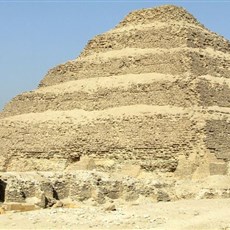
Step Pyramid
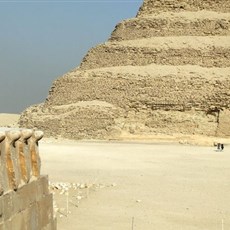
Step Pyramid
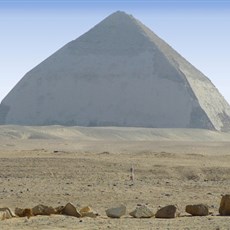
Bent Pyramid
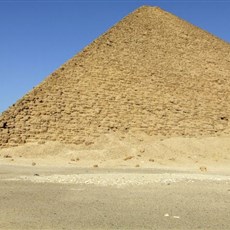
Red Pyramid
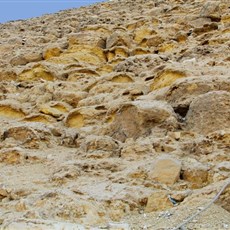
Red Pyramid
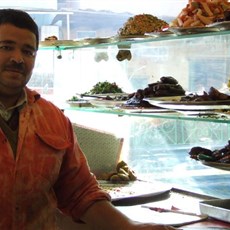
Lunch
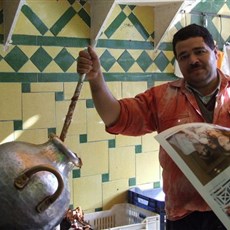
Lunch